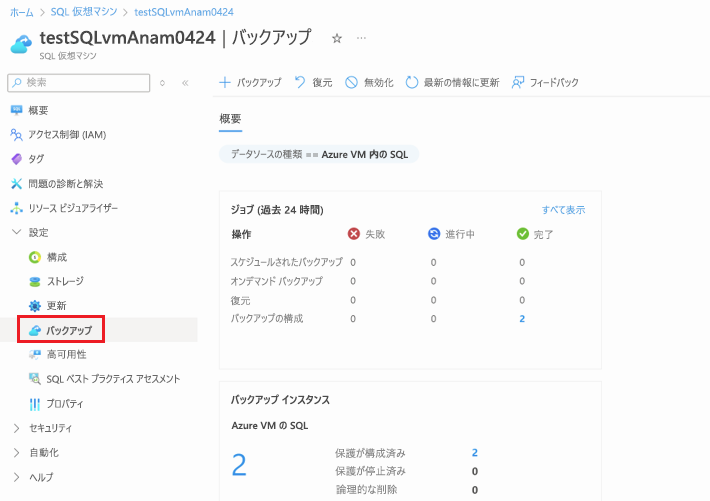この記事では、Azure Backup を使用して、Azure portal を使用して SQL VM リソースから SQL Server (Azure VM で実行) をバックアップする方法について説明します。
SQL Server データベースは、低い目標復旧ポイント (RPO) と長期的なリテンション期間を必要とする重要なワークロードです。 Azure Backup を使用して、Azure 仮想マシン (VM) で実行されている SQL Server データベースをバックアップできます。
注
SQL バックアップでサポートされる構成とシナリオの詳細について説明します。
[前提条件]
SQL Server データベースをバックアップする前に、 バックアップ条件を確認してください。
SQLServer データベースのバックアップを構成する
これで、AZURE VM で実行されている SQL サーバーの Azure バックアップを、SQL VM リソース ブレードから直接構成できるようになりました。
SQL VM ブレードからバックアップを構成するには、次の手順に従います。
Azure portal で、SQL VM リソースに移動します。
注
SQL Server リソースは、仮想マシン リソースとは異なります。
[設定]>[バックアップ]に移動します。
バックアップが VM 用に構成されていない場合は、次のバックアップ オプションが表示されます。
- Azure Backup
- 自動バックアップ
[Azure Backup] ブレードで、[有効にする] を選択して、Azure Backup を使用して SQL Server のバックアップの構成を開始します。
バックアップ操作を開始するには、既存の Recovery Services コンテナーを選択するか 、新しいコンテナーを作成します。
[ 検出 ] を選択して、VM 内のデータベースの検出を開始します。
この操作は、初めて実行されたときに実行されるまでに時間がかかります。
Azure Backup は、VM 上のすべての SQL Server データベースを検出します。 検出中、次の操作がバックグラウンドで実行されます。
Azure Backup は、ワークロード バックアップ用に VM をコンテナーに登録します。 登録されている VM 上のすべてのデータベースは、このコンテナーにのみバックアップできます。
Azure Backup によって、AzureBackupWindowsWorkload 拡張機能が VM にインストールされます。 SQL データベースにエージェントがインストールされていません。
Azure Backup によって、VM 上にサービス アカウント NT Service\AzureWLBackupPluginSvc が作成されます。
すべてのバックアップ操作と復元操作では、サービス アカウントが使用されます。
NT Service\AzureWLBackupPluginSvc には SQL sysadmin アクセス許可が必要です。 Azure Marketplace で作成されたすべての SQL Server VM には、SqlIaaSExtension がインストールされています。
AzureBackupWindowsWorkload 拡張機能は、SQLIaaSExtension を使用して、必要なアクセス許可を自動的に取得します。
操作が完了したら、[バックアップの 構成] を選択します。
次のいずれかのオプションを使用してバックアップ ポリシーを定義します。
- 既定のポリシーとして HourlyLogBackup を選択します。
- SQL 用に以前に作成した既存のバックアップ ポリシーを選択します。
- RPO とリテンション期間の範囲に基づいて新しいポリシーを作成します。
[ 追加] を選択すると、登録されているすべての可用性グループとスタンドアロン SQL Server インスタンスが表示されます。
[バックアップする項目の選択] で、そのインスタンスまたは Always On 可用性グループ内のすべての保護されていないデータベースの一覧を展開します。
保護する データベース を選択し、[ OK] を選択します。
バックアップの読み込みを最適化するために、Azure Backup では、1 つのバックアップ ジョブで最大 50 個のデータベースを許可/許可します。
- 50 を超えるデータベースを保護するには、複数のバックアップを構成します。
- インスタンス全体または Always On 可用性グループを有効にするには、AUTOPROTECT ドロップダウン リストで [オン] を選択し、[OK] を選択します。
[ バックアップの有効化] を 選択して保護の構成操作を送信し、ポータルの [通知] 領域で構成の進行状況を追跡します。
構成済みのバックアップの概要とバックアップ ジョブの概要については、SQL VM リソースの設定>バックアップに関するページを参照してください。
次のステップ
- Azure VM で SQL Server データベースを復元する
- バックアップされた SQL Server データベースの管理と監視
- SQL Server データベースでのバックアップのトラブルシューティング
- FAQ - Azure VM での SQL Server データベースのバックアップ - Azure Backup |Microsoft Learn
関連コンテンツ
- REST API を使用して Azure Backup を使用して Azure VM 内の SQL Server データベースをバックアップします。
- REST API を使用して Azure VM 内の SQL Server データベースを復元します。
- Azure portal、Azure CLI、REST API を使用して、Azure VM 内の SQL Server データベースを管理します。
![SQL VM で [バックアップ] オプションを選択する方法を示すスクリーンショット。](media/backup-sql-server-database-from-azure-vm-blade/select-backups.png)






